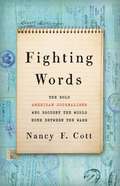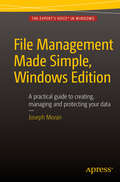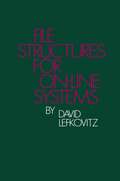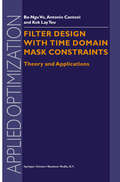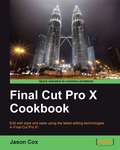- Table View
- List View
Fighting Phishing: Everything You Can Do to Fight Social Engineering and Phishing
by Roger A. GrimesKeep valuable data safe from even the most sophisticated social engineering and phishing attacks Fighting Phishing: Everything You Can Do To Fight Social Engineering and Phishing serves as the ideal defense against phishing for any reader, from large organizations to individuals. Unlike most anti-phishing books, which focus only on one or two strategies, this book discusses all the policies, education, and technical strategies that are essential to a complete phishing defense. This book gives clear instructions for deploying a great defense-in-depth strategy to defeat hackers and malware. Written by the lead data-driven defense evangelist at the world's number one anti-phishing company, KnowBe4, Inc., this guide shows you how to create an enduring, integrated cybersecurity culture. Learn what social engineering and phishing are, why they are so dangerous to your cybersecurity, and how to defend against them Educate yourself and other users on how to identify and avoid phishing scams, to stop attacks before they begin Discover the latest tools and strategies for locking down data when phishing has taken place, and stop breaches from spreading Develop technology and security policies that protect your organization against the most common types of social engineering and phishing Anyone looking to defend themselves or their organization from phishing will appreciate the uncommonly comprehensive approach in Fighting Phishing.
Fighting Terror Online: The Convergence of Security, Technology, and the Law
by Martin Charles GolumbicThis book presents the position that the online environment is a significant and relevant theater of activity in the fight against terror. It identifies the threats, the security needs, and the issues unique to this environment. The book examines whether the characteristics of this environment require new legal solutions, or whether existing solutions are sufficient. Three areas of online activity are identified that require reexamination: security, monitoring, and propaganda.
Fighting Words: The Bold American Journalists Who Brought the World Home Between the Wars
by Nancy F. CottFrom a Harvard historian, this riveting portrait of four trailblazing American journalists highlights the power of the press in the interwar period. In the fragile peace following the Great War, a surprising number of restless young Americans abandoned their homes and set out impulsively to see the changing world. In Fighting Words, Nancy F. Cott follows four who pursued global news -- from contested Palestine to revolutionary China, from Stalin's Moscow to Hitler's Berlin. As foreign correspondents, they became players in international politics and shaped Americans' awareness of critical interwar crises, the spreading menace of European fascism, and the likelihood of a new war -- while living romantic and sexual lives as modern and as hazardous as their journalism. An indelible portrayal of a tumultuous era with resonance for our own, Fighting Words is essential reading on the power of the press and the growth of an American sense of international responsibility.
File Handling on the B. B. C. Microcomputer (PDF)
by Brian J. TownsendFile Handling on the B. B. C. Microcomputer
File Management Made Simple, Windows Edition
by Joseph MoranManaging data is an essential skill that every PC user should have. Surprisingly though, a large number of users--even highly experienced users--exhibit poor file management skills, resulting in frustration and lost data. This brief but invaluable book, File Management Made Simple can resolve this by providing you with the skills and best practices needed for creating, managing and protecting your data.Do any of the following scenarios sound familiar to you? You’ve downloaded an attachment from your e-mail, but aren’t sure where you downloaded it to. You spent an entire evening working on a document only to discover the next morning that you didn’t save it to your flash drive like you thought you had? Maybe you had a guest visiting and wanted to share with them the pictures you took of your kids recital, yet when you went to get them you were unable to recall where you stored them on your PC. Or you scanned your receipts for your expense reports on day and came back the next day and scanned some for another report only to find that the new ones numbered Scan 1, Scan 2,... still exist. Unfortunately, for a vast number of PC users, scenarios like these are all too common. These situations are not only extremely frustrating for the user, but also tend to discourage them from ever wanting to touch a PC again! Why is that? What is the common factor? It’s simple really. Each of these issues can be attributed to poor file management skills. In my experience, the people with the worst file management skills are simply the ones that lack an understanding of how to navigate the Windows operating system. However this situation can be easily rectified. And once you can successfully navigate your computer's drive and folder structure, you'll be hard pressed to misplace anything.Although this process can seem daunting to the uninitiated, this isn’t black magic. In fact, it’s actually quite simple. Keeping your files and folders organized on the computer is no more difficult than keeping them organized in real life. There is a place for everything and everything has its place. We will show you how to navigate Windows correctly and efficiently. Where specific types of files should be stored. We’ll also show you how best to name and manage your files; such as using descriptive folders to identify files, implementing the best naming conventions for files and directories, and how to group various types of data together; ensuring that the data you need is always readily available. Finally we’ll introduce you to some of the best options for transporting and protecting your data. We will show you the skills you need to easily manage your data, using clear and simple English, without the confusing technical jargon. All this and more can be accomplished with File Management Made Simple by your side.
File Structures for On-Line Systems (PDF)
by David LefkovitzIn June, 1967, The Professional Development Seminars of the Association for Computing Machinery offered a one-day course on File Structures for On-Line Systems to its membership, and to the data processing community at large. These seminars were given twenty-four times throughout the United States during 1967 and 1968, and it was the continued and widespread interest in this subject that influenced the author to produce this book. T
FileMaker Pro 9 Bible (Bible #461)
by Ray CologonRefocused and completely rewritten with the needs of business users and FileMaker Pro developers in mind, FileMaker Pro 9 Bible shows you how to design an industrial-strength database, make it intuitive, and automate it with scripts and programming. From the fundamentals to data modeling to writing no-fail code, you'll find the clear, step-by-step procedures, solid techniques, and detailed explanations you need to master this powerful software and build the right solutions for your needs.
FileMaker Pro Design and Scripting For Dummies
by Timothy TrimbleGet the scoop on designing databases for Mac and Windows Use FileMaker Pro design and scripting to quickly, easily build databases that solve real problems FileMaker Pro has grown up, and it's better than ever! This easy-to-use guide shows you how to design a great FileMaker application, build a database that works, add the functionality you need, populate your database, and venture into programming with ScriptMaker. You'll find out how to share and protect your database, too. Discover how to * Build a layout that works * Create custom triggers and calculated fields * Generate reports automatically * Manage security * Publish your database on the Web * Embed pictures, sound, and video
FileMaker Pro Design and Scripting For Dummies
by Timothy TrimbleGet the scoop on designing databases for Mac and Windows Use FileMaker Pro design and scripting to quickly, easily build databases that solve real problems FileMaker Pro has grown up, and it's better than ever! This easy-to-use guide shows you how to design a great FileMaker application, build a database that works, add the functionality you need, populate your database, and venture into programming with ScriptMaker. You'll find out how to share and protect your database, too. Discover how to * Build a layout that works * Create custom triggers and calculated fields * Generate reports automatically * Manage security * Publish your database on the Web * Embed pictures, sound, and video
Film Criticism and Digital Cultures: Journalism, Social Media and the Democratization of Opinion (International Library of the Moving Image (PDF))
by Andrew McWhirterHistorical perspectives on criticism from ancient times and current debates in journalism and digital media are used to unravel questions, such as: what is the relationship between crisis and criticism? In what way does the web change the functions and habits of practitioners? What influences do film industries have on the critical act? And how engaged are practitioners with converged and creative film criticism such as the video essay? In the face of transformative digital idealism, empirical findings here redress the balance and argue the case for evolution rather than revolution taking place within film criticism.
Filter Banks and Audio Coding: Compressing Audio Signals Using Python
by Gerald SchullerThis textbook presents the fundamentals of audio coding, used to compress audio and music signals, using Python programs both as examples to illustrate the principles and for experiments for the reader. Together, these programs then form complete audio coders. The author starts with basic knowledge of digital signal processing (sampling, filtering) to give a thorough introduction to filter banks as used in audio coding, and their design methods. He then continues with the next core component, which are psycho-acoustic models. The author finally shows how to design and implement them. Lastly, the author goes on to describe components for more specialized coders, like the Integer-to-Integer MDCT filter bank, and predictive coding for lossless and low delay coding. Included are Python program examples for each section, which illustrate the principles and provide the tools for experiments.Comprehensively explains the fundamentals of filter banks and audio coding;Provides Python examples for each principle so that completed audio coders are obtained in the language;Includes a suite of classroom materials including exercises, experiments, and examples.
The Filter Bubble: What The Internet Is Hiding From You
by Eli PariserImagine a world where all the news you see is defined by your salary, where you live, and who your friends are. Imagine a world where you never discover new ideas. And where you can't have secrets.Welcome to 2011.Google and Facebook are already feeding you what they think you want to see. Advertisers are following your every click. Your computer monitor is becoming a one-way mirror, reflecting your interests and reinforcing your prejudices.The internet is no longer a free, independent space. It is commercially controlled and ever more personalised. The Filter Bubble reveals how this hidden web is starting to control our lives - and shows what we can do about it.
Filter Design With Time Domain Mask Constraints: Theory and Applications (Applied Optimization #56)
by Ba-Ngu Vo Antonio Cantoni Kok Lay TeoOptimum envelope-constrained filter design is concerned with time-domain synthesis of a filter such that its response to a specific input signal stays within prescribed upper and lower bounds, while minimizing the impact of input noise on the filter output or the impact of the shaped signal on other systems depending on the application. In many practical applications, such as in TV channel equalization, digital transmission, and pulse compression applied to radar, sonar and detection, the soft least square approach, which attempts to match the output waveform with a specific desired pulse, is not the most suitable one. Instead, it becomes necessary to ensure that the response stays within the hard envelope constraints defined by a set of continuous inequality constraints. The main advantage of using the hard envelope-constrained filter formulation is that it admits a whole set of allowable outputs. From this set one can then choose the one which results in the minimization of a cost function appropriate to the application at hand. The signal shaping problems so formulated are semi-infinite optimization problems. This monograph presents in a unified manner results that have been generated over the past several years and are scattered in the research literature. The material covered in the monograph includes problem formulation, numerical optimization algorithms, filter robustness issues and practical examples of the application of envelope constrained filter design. Audience: Postgraduate students, researchers in optimization and telecommunications engineering, and applied mathematicians.
Filterbänke und Audiocodierung: Komprimierung von Audiosignalen mit Python
by Gerald SchullerDieses Lehrbuch stellt die Grundlagen der Audiocodierung vor, die zur Komprimierung von Audio- und Musiksignalen verwendet wird. Dabei werden Python-Programme sowohl als Beispiele zur Veranschaulichung der Prinzipien als auch für Experimente für den Leser verwendet. Zusammen bilden diese Programme dann komplette Audiocodierer. Der Autor beginnt mit grundlegenden Kenntnissen der digitalen Signalverarbeitung (Abtastung, Filterung), um eine gründliche Einführung in Filterbänke, wie sie in der Audiocodierung verwendet werden, und deren Entwurfsmethoden zu geben. Er fährt dann mit der nächsten Kernkomponente fort, den psycho-akustischen Modellen. Der Autor zeigt schließlich, wie man sie entwirft und implementiert. Schließlich beschreibt der Autor Komponenten für speziellere Kodierer, wie die Integer-to-Integer MDCT-Filterbank und prädiktive Kodierung für verlustfreie und verzögerungsarme Kodierung. Zu jedem Abschnitt gibt es Python-Programmbeispiele, die die Prinzipien veranschaulichen und die Werkzeuge für Experimente bereitstellen. Umfassende Erläuterung der Grundlagen von Filterbänken und Audiocodierung; Bietet Python-Beispiele für jedes Prinzip, so dass fertige Audiocodierer in der Sprache erhalten werden; Enthält eine Reihe von Unterrichtsmaterialien mit Übungen, Experimenten und Beispielen.
Filtering Techniques for Turbulent Flow Simulation (Lecture Notes in Engineering #56)
by Alvaro A. Aldama1. 1 Scope of the Study The detailed and reasonably accurate computation of large scale turbulent flows has become increasingly important in geophysical and engi neering applications in recent years. The definition of water quality management policies for reservoirs, lakes, estuaries, and coastal waters, as well as the design of cooling ponds and solar ponds, requires an ade quate quantitative description of turbulent flows. When the diffusion of some tracer (be it active, such as temperature or salinity, or passive, such as dissolved oxygen) is of relevance to a specific application, the proper determination of the effects of turbulent transport processes has paramount importance. Thus, for instance, the proper understanding of lake and reservoir dynamics requires, as a first step, the ability to simulate turbulent flows. Applications in other areas of geophysical research, such as meteorology and oceanography are easily identified and large in number. It should be stressed that, in this context, the analyst seeks predictive ability to a certain extent. Accordingly, the need for simulation models that closely resemble the natural processes to be repre sented has recently become more evident. Since the late 1960s considerable effort has been devoted to the development of models for the simulation of complex turbulent flows. This has resulted in the establishment of two approaches which have been, or 2 have the potential for being, applied to problems of engineering and geophysical interest.
Filtering the Web to Feed Data Warehouses
by Witold Abramowicz Pawel J. Kalczynski Krzysztof WecelInformation is a key factor in business today, and data warehousing has become a major activity in the development and management of information systems to support the proper flow of information. Unfortunately, the majority of information systems are based on structured information stored in organizational databases, which means that the company is isolated from the business environment by concentrating on their internal data sources only. It is therefore vital that organizations take advantage of external business information, which can be retrieved from Internet services and mechanically organized within the existing information structures. Such a continuously extending integrated collection of documents and data could facilitate decision-making processes in the organization. Filtering the Web to Feed Data Warehouses discusses areas such as:- how to use data warehouse for filtering Web content- how to retrieve relevant information from diverse sources on the Web - how to handle the time aspect - how to mechanically establish links among data warehouse structures and documents filtered from external sources - how to use collected information to increase corporate knowledge and gives a comprehensive example, illustrating the idea of supplying data warehouses with relevant information filtered from the Web.
Final Cut Pro HD For Dummies
by Helmut Kobler“Save it in the edit” is a common saying among film professionals. Editing makes the difference between boring vacation movies and exciting travelogues…between the whole dull news conference and the highlights on the evening news. Whether you’re a budding Spielberg, a proud parent who wants two-year-old Junior’s every feat documented for posterity, or a band that wants your music video to rock, Final Cut Pro HD For Dummies tells you what you need to know to edit regular digital or high definition video like a pro. It covers the basics of capturing, importing, and editing digital videos, with detailed how-to for: Organizing your media Navigating the audio and video Timeline tracks and selecting clips and frames on the Timelines Getting fancier with split, roll, ripple, slip, and slide edits Working with audio, including mixing, editing out scratches and pops, and using filters to create effects Using Soundtrack to compose a musical score, even if you don’t know the difference between horns and strings Apply transitions such as 3D simulation, dissolve, iris, stretch and squeeze, and more Adding text for captions, opening titles, and closing credits Color-correcting video Compositing, rendering, and outputting your final product to tape, CD, DVD, or the Web Three bonus chapters online go into more depth about rendering, customizing the interface, and managing media so you can refine your skills even further. Final Cut Pro HD For Dummies was written by Helmut Kobler, a Los Angeles-based filmmaker, owner of K2Films, and a frequent contributor to Macaddict Magazine. Having this book next to your editing equipment is the next best thing to having him sit next to you and guide you through the editing process.
Final Cut Pro X Cookbook
by Jason CoxWritten in cookbook style, this book offers many recipes to edit slick, professional videos with FCPX. Each recipe contains step-by-step instructions followed by analysis of what was done in each task and other useful information. The book is designed so that you can read it chapter by chapter, or you can look at the list of recipes and refer to them in no particular order. If you've been toying around with iMovie and want more power or you've taken FCPX for a whirl and simply can't find the fastest, most efficient workflow, this book will help! Veteran editors will find just as much useful info as FCPX is radically different than its predecessor, Final Cut Pro 7.
Final Cut Pro X Efficient Editing: Smart, quick, and effective video editing with FCP X 10.4.10
by Iain AndersonFrom basic editing workflows to finishing and exporting your final cut, explore the features of Final Cut Pro X with this practical guideKey FeaturesExplore the best ways to use FCP X, from importing and editing to finishing and exporting the final cutUnlock the power of editing in the magnetic timeline to make huge changes or subtle adjustments easilyFinish your project with pro-level color correction, effects, transitions, audio, titles, and captionsBook DescriptionFinal Cut Pro X (FCP X) is Apple's efficient and accessible video editing software for everyone, but it offers powerful features that experienced editors will find useful too. FCP X is the quickest way to transform your raw clips into a finished piece, so if speed is important, make this a key tool in your editing arsenal.Final Cut Pro X Efficient Editing is a comprehensive best practice guide for all editors. You'll not only learn how to use the features but also find out which ones are the most important and when you should use them. With the help of practical examples, the book will show you how typical footage can be assembled, trimmed, colored, and finessed to produce a finished edit, exploring a variety of techniques. As you progress through the book, you'll follow a standard editing workflow to get the feel of working on real-world projects and answer self-assessment questions to make sure that you're on track.By the end of this Final Cut Pro X book, you'll be well versed with the key features of this app and have all the tools you need to create impressive edits.What you will learnUnderstand the media import process and delve into media managementEffectively organize your footage so you can find the right shot quicklyDiscover how to assemble a rough cut editExplore trimming and advanced editing techniques to finesse and finalize the editEnhance the edit with color correction, effects, transitions, titles, captions, and much moreSweeten the audio by controlling volume, using compression, and adding effectsShare the final edited video and archive the jobWho this book is forThe book is for creative professionals, anyone starting out in video editing, and editors switching to Final Cut Pro X from another video editing system. Whether you are a beginner or a professional, you'll find this FCPX book useful. All you need to get started is familiarity with macOS.
Finance 4.0 - Towards a Socio-Ecological Finance System: A Participatory Framework to Promote Sustainability (SpringerBriefs in Applied Sciences and Technology)
by Dirk Helbing Marcus M. Dapp Stefan KlauserThis Open Access book outlines ideas for a novel, scalable and, above all, sustainable financial system.We all know that today’s global markets are unsustainable and global governance is not effective enough. Given this situation, could one boost smart human coordination, sustainability and resilience by tweaking society at its core: the monetary system? A Computational Social Science team at ETH Zürich has indeed worked on a concept and little demonstrator for a new financial system, called “Finance 4.0” or just “FIN4”, which combines blockchain technology with the Internet of Things (“IoT”). What if communities could reward sustainable actions by issuing their own money (“tokens”)? Would people behave differently, when various externalities became visible and were actionable through cryptographic tokens? Could a novel, participatory, multi-dimensional financial system be created? Could it be run by the people for the people and lead to more societal resilience than today’s financial system (which is effectively one-dimensional due to its almost frictionless exchange)? How could one manage such a system in an ethical and democratic way? This book presents some early attempts in a nascent field, but provides a fresh view on what cryptoeconomic systems could do for us, for a circular economy, and for scalable, sustainable action.
Finance for IT Decision Makers: A practical handbook
by Michael BlackstaffFinance is as fundamental to the IT world as it is to most other aspects of life. However, many IT professionals lack knowledge of the particular financial principles on which decisions about IT should be based. Assuming no prior knowledge, this new edition covers all relevant aspects of finance and is updated with International Financial Reporting Standards (IFRS) terminology. It is ideal for all IT decision makers who wish to conquer their fear of finance or refresh existing knowledge.
Finance for IT Decision Makers: A Practical Handbook for Buyers, Sellers and Managers (Practitioner Series)
by Michael BlackstaffInformation technology decisions are usually made by IT experts who often lack the finance and accounting skills to fully understand the financial implications of this capital spending. This book is aimed at IT managers, addressing issues such as: how to budget and account for IT appropriately; how to build a financial case for IT investment; how to use investment appraisal techniques, as well as how to use numerous financial tricks of the trade.
Finance for IT Decision Makers: A practical handbook (British Comp Society Ser.)
by Michael BlackstaffFinance is as fundamental to the IT world as it is to most other aspects of life. However, many IT professionals lack knowledge of the particular financial principles on which decisions about IT should be based. Assuming no prior knowledge, this new edition covers all relevant aspects of finance and is updated with International Financial Reporting Standards (IFRS) terminology. It is ideal for all IT decision makers who wish to conquer their fear of finance or refresh existing knowledge.
Financial Analysis and Risk Management: Data Governance, Analytics and Life Cycle Management
by Victoria LemieuxThe Global Financial Crisis and the Eurozone crisis that has followed have drawn attention to weaknesses in financial records, information and data. These weaknesses have led to operational risks in financial institutions, flawed bankruptcy and foreclosure proceedings following the Crisis, and inadequacies in financial supervisors’ access to records and information for the purposes of a prudential response. Research is needed to identify the practices that will provide the records, information and data needed to support more effective financial analysis and risk management. The unique contribution of this volume is in bringing together researchers in distinct domains that seldom interact to identify theoretical, technological, policy and practical issues related to the management of financial records, information and data. The book will, therefore, appeal to researchers or advanced practitioners in the field of finance and those with an interest in risk management, computer science, cognitive science, sociology, management information systems, information science, and archival science as applied to the financial domain.
Financial Cryptography: 6th International Conference, FC 2002, Southampton, Bermuda, March 11-14, 2002, Revised Papers (Lecture Notes in Computer Science #2357)
by Matt BlazeThe Sixth International Financial Cryptography Conference was held during March 11-14, 2002, in Southampton, Bermuda. As is customary at FC, these proceedings represent "final" versions of the papers presented, revised to take into account comments and discussions from the conference. Submissions to the conference were strong, with 74 papers submitted and 19 accepted for presentation and publication. (Regrettably, three of the submit ted papers had to be summarily rejected after it was discovered that they had been improperly submitted in parallel to other conferences.) The small program committee worked very hard under a tight schedule (working through Christmas day) to select the program. No program chair could ask for a better committee; my thanks to everyone for their hard work and dedication. In addition to the refereed papers, the program included a welcome from the Minister of Telecommunications and e-Commerce, Renee Webb, a keynote address by Nigel Hickson, and a panel on privacy tradeoffs cheiired by Rebecca Wright (with panelists Ian Goldberg, Ron Rivest, and Graham Wood). The traditional Tuesday evening "rump session" was skillfully officiated by Markus Jakobsson. My job as program chair was made much, much easier by the excellent work of our general chair, Nicko van Someren, who performed the miracle of hiding from me any evidence of the innumerable logistical nightmares associated with conducting this conference. I have no idea how he did it, but it must have involved many sleepless nights.


